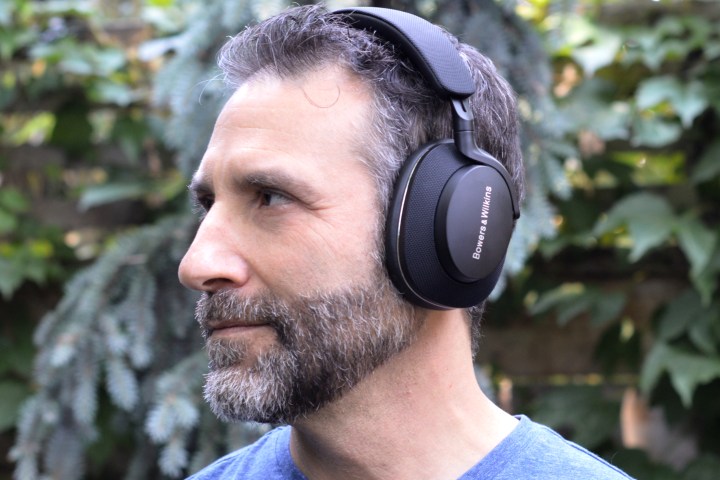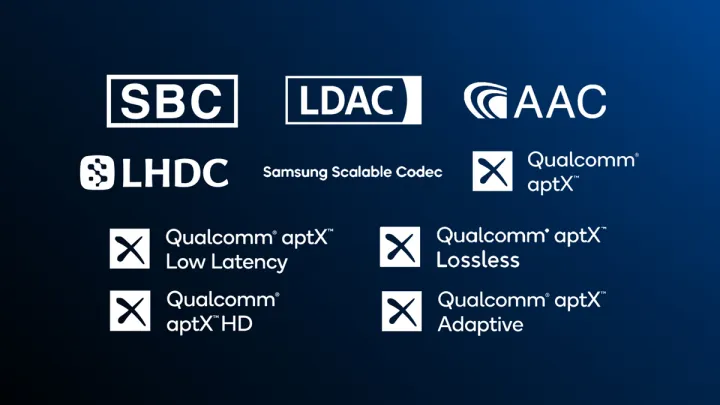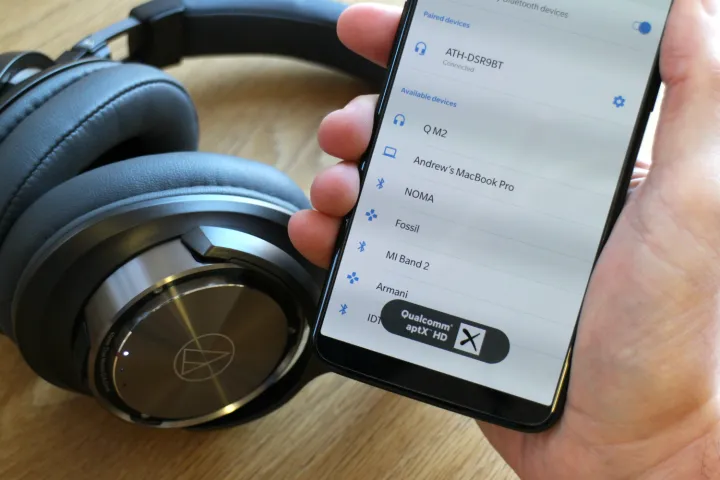As wireless headphones and, especially, wireless earbuds have grown in popularity, so has the tech jargon that goes along with these devices. Wireless charging, Bluetooth multipoint, wear sensors, ANC and transparency, IPX ratings, spatial audio … it’s enough to make your head spin.
While most of these terms relate to features that are pretty easy to understand, there’s one term that’s guaranteed to confuse: Bluetooth codecs.
What are they? And why should you spend any time thinking about them? We’ll break it down with a plain-language explainer so that the next time you read a headphone review that criticizes the lack of aptX, AAC, or LDAC support, you’ll know what the reviewer is talking about. But more importantly, you’ll know why it might (or might not) matter to you.
Let’s get into it.
What is a Bluetooth codec?

Bluetooth, as a wireless technology, has traditionally been fairly limited in terms of bandwidth. Each new version of Bluetooth (we’re up to version 5.3 as of 2022) adds a bit more bandwidth than its predecessor, but it’s still nowhere near as capacious as, say, Wi-Fi. (Nor is it meant to be.)
Because some kinds of digital audio can be too massive to be streamed in real-time over that limited bandwidth, it needs to be re-packaged to fit. If Bluetooth didn’t do that, when you hit play in Spotify it could take 10 seconds or longer before you heard anything on your wireless headphones. Bluetooth codecs are the key to that repackaging and streaming process.
The word codec, by the way, is a portmanteau for encoding and decoding, which is geek-speak for packaging and unpackaging.
Why is there more than one type of Bluetooth codec?

As with all things technological, improvements get made over time as we get better at creating software and hardware. When wireless stereo headphones first appeared, there was only one Bluetooth codec: SBC, or sub-band codec. And to this day, if your phone, computer, headphones, or earbuds only supports one codec, it’s SBC.
SBC is reliable and always gets the job done, but it wasn’t built for high-quality or low-latency applications. In the early 2000s, when stereo audio was added to Bluetooth, the highly-compressed MP3 file format still reigned supreme. Today’s music streaming services hadn’t arrived, and almost nobody was talking about the need to support lossless music in 24-bit/96kHz. Mobile gaming still was many years from becoming mainstream.
But as these scenarios started to creep closer to center stage, it became apparent that we needed new codecs that could take us beyond SBC’s limitations. We now have at least 10 Bluetooth codecs that exceed SBC in some way. Some offer lower latency (the time it takes from when your device makes a sound to when your headphones let you hear that sound), some offer higher quality audio, some are built to be more energy efficient, and some try to do a little bit of everything. And as of 2022, the list of beyond-SBC Bluetooth codecs is astonishingly long:
- AAC
- aptX
- aptX Low Latency (LL)
- aptX HD
- aptX Adaptive
- aptX Lossless
- LDAC
- LHDC/LLAC
- LC3
- MQair
- Samsung Scalable Codec (SSC)/Seamless Hi-Fi Codec
Do I need to care about Bluetooth codecs?

If your head is now swimming, take a deep breath, because we’ve got good news: Unless you have a very specific need, like you’re a competitive gamer who needs ultra-fast response times, or you’re an audiophile in search of the best possible sound quality, you can probably stop reading.
Even though some wireless features can’t be fully appreciated unless you use one or more of the specific codecs listed above, the bottom line is that all Bluetooth devices support SBC. So don’t worry — even if you don’t know the difference between these codecs, your chosen audio products will still work perfectly well together.
How do Bluetooth codecs work?

As the word codec implies, if you encode information, you need to be able to decode it on the other end, and codec compatibility is key. For a codec to work, it needs to be supported on both the sending and receiving ends. If your earbuds support aptX, for instance, but your phone doesn’t, you won’t be able to use the aptX codec.
When two Bluetooth devices connect, they relay which codecs they support. In general, they will default to the highest quality mutually supported codec. So if two devices support aptX, they’ll use that instead of SBC.
But if they can’t find any common ground — e.g. one supports AAC but not aptX, and the other supports aptX but not AAC — they will fall back on good ol’ SBC.
This is where I have some bad news for Apple fans. Your iPhone, iPad, Apple Watch, and to a lesser degree your Macs, only support two codecs: SBC and AAC — neither of which supports hi-res, 24-bit audio, or low-latency operation.
Android owners have more options, but beware: Android is a highly fragmented world in which some handsets support virtually all of the most common codecs, while others only support some. Google’s Pixel phones are a good example. They support AAC, LDAC, and both aptX and aptX HD, but they don’t support Qualcomm’s aptX Adaptive or aptX Lossless codecs.
What’s the difference between Bluetooth codecs?
As we mentioned above, ever since SBC, codecs have been attempting to improve sound quality, latency, and energy efficiency, or they perform a balancing act that prioritizes one or two at the expense of the third.
You can improve latency and energy efficiency by reducing the amount of computational processing done by a codec, but this often leads to drops in sound quality. Conversely, if you try to deliver higher-quality sound by using more bandwidth or performing sophisticated computational audio processing, you run the risk of increasing latency and degrading battery life.
Both of these scenarios are perfectly acceptable tradeoffs if they deliver the thing that you value the most. That’s why we have so many codecs.
Let’s take a look at the specific benefits offered by each Bluetooth codec.
Sub-band Codec (SBC)
Pros:
- Supported by all Bluetooth devices
- Decent audio quality for casual listening
Cons:
- Old standard that hasn’t been optimized for newer devices
- Can suffer from longer latency
- Doesn’t support hi-res or lossless audio
Advanced Audio Coding (AAC)
Pros:
- Default high-quality codec for all Apple devices
- Very good audio quality
Cons:
- More demanding of battery life because of greater computational complexity
- Can suffer from poorer performance and longer latency, especially on Android devices
- Doesn’t support hi-res or lossless audio
Low Complexity Communication Codec (LC3)
Pros:
- Designed to be more power-efficient than other codecs
- Supports bit-depths up to 32-bit
- Lower latency than SBC and AAC
- Works with both hearing aids and wireless audio products
Cons:
- Doesn’t support hi-res or lossless audio
Qualcomm aptX family codecs (aptX, aptX HD, aptX LL, aptX Adaptive, and aptX Lossless)
Pros:
- Lower latency, less computationally demanding than AAC, especially aptX LL
- More energy efficient than SBC
- Capable of hi-res lossy audio up to 24-bit/96kHz (aptX HD, aptX Adaptive) or 16-bit/44.1kHz CD-quality lossless audio (aptX Lossless)
- The most widely supported hi-res codecs on wireless headphones and earbuds (aptX HD, aptX Adaptive)
- Can adjust on the fly to wireless and audio conditions to maintain maximum quality (aptX Adaptive)
- The first (and currently only) lossless Bluetooth codec (aptX Lossless)
Cons:
- Not supported on Apple devices
- Not always included by default on Android devices (aptX Adaptive/Lossless)
- Can be confusing due to the number of different versions
LDAC
Pros:
- Certified for hi-res, lossy audio up to 24-bit/96kHz
- Included within the Android operating system since version 8.0
- Supported by all of Sony’s flagship wireless headphones, earbuds, soundbars, and a variety of other audio devices
Cons:
- Not supported on Apple devices
- Can be very power-hungry
- Sometimes high latency makes it a poor choice for gaming/watching TV or movies
- Headphone/earbud support is less common than aptX codecs
- Best audio quality requires short distances between devices, with little or no interference from other wireless signals
Low Latency High-Definition Audio Codec (LHDC/LLAC)
Pros:
- Certified for hi-res, lossy audio up to 24-bit/96kHz
- Latency comparable to aptX LL (LLAC)
- Available as a license-free option within the Android operating system since version 10.0
Cons:
- Not supported on Apple devices
- Hard to find on Android devices
- Low support among major headphone makers
MQair
Pros:
- Can theoretically support a huge array of audio qualities as bandwidth is available because it can scale its bit rate from less than 220 Kbps up to 20 Mbps
- Certified for wireless hi-res audio
- It’s the only codec that can pass along the MQA format wirelessly so that it can be decoded by a set of headphones or earbuds
Cons:
- Not currently offered by any device manufacturer
Samsung Scalable Codec (SSC) / Seamless Hi-Fi Codec
Pros:
- Support for hi-res, lossy audio up to 24-bit/96kHz
- Can adjust on the fly to wireless and audio conditions to maintain maximum quality (aptX Adaptive)
Cons:
- Only available when you use a compatible Samsung phone and Samsung earbuds
Bluetooth codec buying advice
So, when it comes right down to it, does any of this matter when choosing a new set of wireless earbuds or headphones, or possibly a phone? Yes and no.
Buying for sound quality

A million variables go into wireless headphones. Things like audio source and driver size. Or design and materials. The quality and power of amplification. The use of digital signal processing, quality of digital-to-analog conversion, and the Bluetooth codec being used. It all factors into sound quality. But even then, the codec would be among the least important ingredients.
In other words, a hi-res codec like aptX Adaptive or LDAC cannot make a lower-quality set of cans sound better, just like putting high-octane fuel in a minivan won’t turn it into a sports car.
So if you’re buying a budget set of earbuds or headphones — and you’re not into gaming — codecs probably are not something you need to worry about. (Or even think about, for that matter.)
I’ve listened to several sub-$100 earbuds that sound great, even though they only support the base-level SBC codec.
But if you’re looking to make a big investment in wireless earbuds or headphones in order to get top-quality sound, codecs can and do make a difference. When I’ve auditioned high-end headphones like Bowers & Wilkins Px7 S2, Master & Dynamic MW75, or the crazy-expensive Mark Levinson No.5909, and then alternated between an iPhone with AAC and an Android device with LDAC or AptX Adaptive, the difference was immediately noticeable.
When using these hi-res codecs, detail, dynamic range, and soundstage accuracy were all improved. Would you notice the difference if you were listening to a low-bit rate Spotify stream while commuting on a busy bus or train? Not a chance. But if you have access to hi-res, lossless content via a streaming service or your own personal collection of music, and you can find a quiet place to chill, it’s the bees’ knees.
Buying for gaming performance

Gamers — particularly those who play rapid-action first-person shooters or other genres where reaction speed is critical — need to be on the lookout for products that offer low-latency codecs. Latency is measured in milliseconds and is best described as the time between an on-screen flash that you see, and the corresponding bang that you hear. The lower that time, the faster you’ll be able to react to what’s happening in your game.
The absolute best way to reduce latency for gaming is to buy a set of gaming headphones or earbuds that come with their own dedicated wireless transmitter. This sidesteps the question of Bluetooth altogether, delivering latency as low as 20 milliseconds — we’re talking 20-thousandths of a second.
But for a more flexible solution, you can look for a set of wireless headphones that support aptX LL. With delays measuring between 30-40 milliseconds, this is about as close to a dedicated wireless setup as you can get. But there’s a catch.
Even though aptX LL is a Bluetooth codec, it’s not available on phones. It requires its own dedicated antenna instead of the antennas in phones that are often shared between Bluetooth and Wi-Fi connections. To get aptX LL, you’ll not only need a set of headphones that support it, like the Sennheiser HD 450BT, but also a dedicated aptX LL USB dongle that you can plug into your computer or game console.
For mobile gaming, lower latency times are still possible — they simply won’t get quite as low as aptX LL. Look for headphones and earbuds that offer a gaming mode or a low-latency mode. Sometimes this means the earbuds turn off any extra sound processing they may be using (which would otherwise increase latency), but it could also mean the earbuds are using Qualcomm’s aptX Adaptive’s ability to automatically adjust to the content you’re listening to. AptX Adaptive’s low-latency mode can reduce times to under 100 milliseconds — not as fast as aptX LL, but a good deal faster than both SBC and AAC, which can run anywhere between 150-300 milliseconds.
Editors' Recommendations
- Bluetooth on Sonos’ new Era speakers isn’t what you think – it’s better
- What is Sonos? The speakers, app, and everything you need to know about wireless music
- The first Roku-made televisions are now available at Best Buy
- Sonos’ new Era 100 and Era 300 wireless speakers go all-in on spatial audio and Bluetooth
- The best wireless headphones for 2023: which should you buy?






